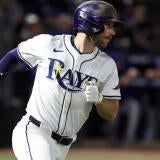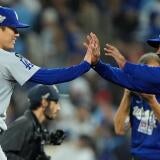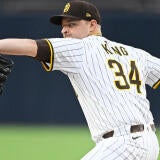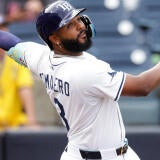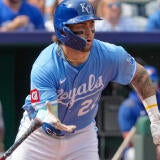Fantasy Baseball: Buy or sell hot starts from Anthony Volpe, Michael Busch, and more
It's never too early to test the trade market
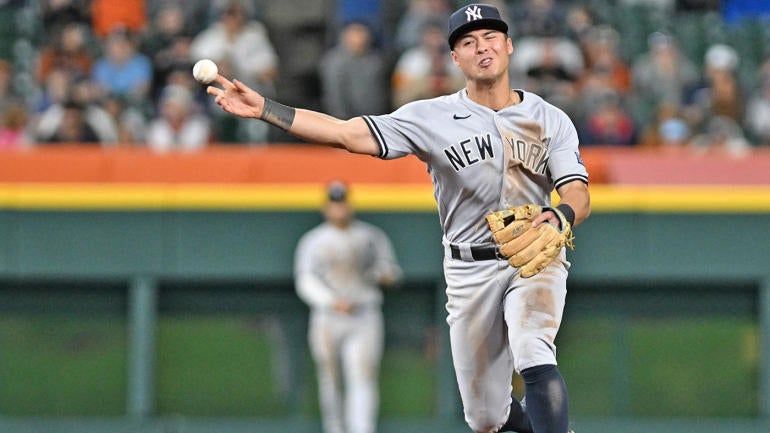
The major-league leader in plate appearances entering play Monday has 86. If we don't count the Dodgers and Padres, who started the season a week ahead of everyone else, the leader in PA is Kyle Tucker, with 79. Last season, Marcus Semien led the majors in plate appearances with 753.
Which is to say, we're still dealing with some awfully small sample sizes here. We're dealing with the kinds of sample sizes so far that, had they occurred in May or June, you probably wouldn't have even noticed. Did you notice, for example, the 14-game stretch last May when Ronald Acuña had just a .657 OPS and no homers? I'd bet you didn't! So, why worry about his current 14-game stretch without a homer?
Of course, not every player is as sure of a thing as Ronald Acuña, so there is still room for reacting to some of what we've seen so far. You probably shouldn't be fundamentally changing how you view any player without really compelling evidence, and 14-18 games is rarely going to provide us with really compelling evidence. But that doesn't mean we can't look at some of the hot starts around baseball and try to figure out if we should be buying in. So that's what we're doing today.
I'm writing about five of the hottest starts in Fantasy through the first couple of weeks to try to figure out if Fantasy players should be buying them, or looking to sell:
Anthony Volpe, SS, Yankees – No. 4 shortstop
Volpe's rookie season showed a nice base of skills to build on or a fundamentally flawed swing, depending on if you wanted to be optimistic or pessimistic. But, for his part, Volpe didn't rest on his laurels after a 20-20 season where he won a Gold Glove and finished eighth in Rookie of the Year voting, and that might be why he's actually on pace to live up to the lofty expectations he carried with him to the majors.
Volpe reworked his swing this offseason, after finding that his uppercut swing from his rookie season – the swing that made him one of the best prospects in baseball, mind you – wasn't working for him. He worked on flattening his swing path, as Yankees hitting coach James Rowson put it, to "make sure he got into the zone early, made sure he stayed in the zone long, didn't worry so much about lifting the ball."
I was skeptical that this approach would pay dividends for Volpe, who didn't show the kind of raw power as a rookie to succeed with a more line-drive, all-fields kind of approach. But it's worked incredibly well so far for him. Volpe has had to trade a little bit of oomph so far, with his barrel rate dropping from 9% to 4.3% in the early going, but what's interesting is, that's not because he's not hitting the ball as hard as he did. In fact, both his average exit velocity (91.1 mph) and hard-hit rate (50%) have jumped from middling marks to the very, very good range; the lower barrel rate is coming from hitting fewer of his hard-hit balls as fly balls and more as grounders and line drives.
And that change in approach might put a lower ceiling on Volpe's power potential … if he can't sustain the other gains he's made, most notably the drop in strikeout rate from 27.8% to 13.6%. And the swing change might also be playing a big part in that, too. As BaseballProspectus' Daniel R. Epstein noted in a piece Monday, Volpe is doing a much better job catching up to high fastballs, a pitch he was especially prone to swinging and missing through last season. This new swing is allowing Volpe to cover the plate much better, keeping his bat in the zone longer and helping him get to pitches he swung through a year ago.
The biggest question for me with this move was whether sacrificing some of the power he hit for last season would be worth it, but so far, it has been. He's barely swinging and missing right now and he's hitting the ball in a way that should lead to excellent batting average results, and that's exactly what we wanted to see from Volpe if he was going to be sacrificing power. More importantly, he's also running a lot more, with five steals already in 15 games; he had 24 in 159 a year ago.
All in all, Volpe looks a lot more like someone like Nico Hoerner than he did a year ago, and that looks like a tradeoff well worth making, especially since his hot start has pushed him up in the Yankees order. I'm still skeptical about the contact rate gains, especially against non-fastballs, but there are really very few holes you can poke in his game right now. There will be regression coming, but even if Volpe loses 100 points in batting average, he could still be a difference maker in any format in Fantasy. I'm buying Volpe's early-season leap into the top-12 at SS.
Michael Busch, 3B, Cubs – No. 3 third baseman
I'm probably more inclined to buy Busch's hot start than any other player listed here, just because this is exactly who he was in the minors. Busch is a career .293/.385/.544 hitter at Triple-A, with terrific quality-of-contact metrics, and now he's hitting .327/.410/.731 with terrific quality-of-contact metrics in the majors. His .477 wOBA probably isn't sustainable, except it's backed up by a .473 expected wOBA. Which is to say, he's earned every bit of this hot start.
Of course, that doesn't mean he'll be able to sustain this. To a certain extent, Busch is likely just hot, and won't be one of the dozen or so best hitters in baseball this season. But he's improved his biggest flaw from his dreadful MLB debut last season, as he is crushing fastballs so far, with a .507 xwOBA against them; last season, it was just .217, a horrific mark. Opposing pitchers are still playing to last year's scouting report, as the rate of fastballs he has faced so far is 58%, up from 52% in 2023.
Major-league pitchers are good. They'll find your weaknesses and exploit them, just like they did with Busch a year ago. But now, he seems to have fixed that weakness, so they need to find what his new one is. I'm sure they'll find something to take advantage of. But for now, Busch looks like arguably the most under-rostered player in CBS Fantasy even up at 80%, and I'm buying him as a top-15 3B the rest of the way. If not more.
Ivan Herrera, C, Cardinals – No. 5 catcher
Because the Cardinals had Yadier Molina and then signed Willson Conteras to a long-term contract last offseason, there's never really been much reason for hype to build around Herrera in Fantasy circles. That is until he forced the issue with his red-hot start to this season, taking advantage of a few minor injuries to Contreras to get off to a .294/.297/.559 line through 10 games. But there's been things to get excited about in Herrera's skill set for a while now.
For most of his minor-league career, Herrera hit for either power or average, which was enough to make him a top-10 prospect in their system, but didn't do much to force him onto national prospect radars. However, he did both in 2023, hitting .297/.409/.500 with 75 walks and 77 strikeouts in 83 games at Triple-A, with some pretty impressive underlying skills. He bumped his max exit velocity to 113.3 mph and his hard-hit rate to 43.3%. Among 28 catchers who had at least 200 batted balls in 2023, only seven had a higher max exit velocity, and only nine had a higher hard-hit rate.
And he's kept it up in the early going this season, leading all catchers with a 16.2% barrel rate, with the eight-highest average exit velocity while making plenty of contact despite some not-great swing decisions. He covers the plate well and has a little bit of that Yainer Diaz/Salvador Perez approach, allowing him to do damage despite those not-great swing decisions. I don't think he's suddenly going to usurp Contreras as the Cardinals primary catcher, but Contreras has already served as DH four times this season, and if they put him in that spot even 20% of the time, we could see Herrera starting around half the team's games. That's not enough to make Herrera a top-12 catcher, but it should make him a top-24 option for those of your in two-catcher leagues.
Buy the skillset and hope the playing time follows.
Jake Cronenworth, 1B, Padres – No. 9 first baseman
Cronenworth's hot start is one of the tougher types to judge, because .. it kind of just looks like he's hot. His plate discipline looks about as solid as it always has – a bit more contact, a bit less patience than normal, but given the small sample sizes we're dealing with, a two percentage point swing in walk and strikeout rate doesn't really mean anything.
But that jump to a 91 mph average exit velocity sure might. Right? Well, not necessarily.
Cronenworth has had 56 batted balls with a 91 mph average exit velocity so far this season, which is, indeed, one of the best stretches of his career by that measure. But's hardly some kind of gigantic outlier that should lead us to re-evaluate how we look at Cronenworth. In fact, he had one stretch from late July through mid-August where his average exit velocity over 55 batted balls was 92.3 mph; he had another stretch in August and September of 2020 when he averaged 92.8 mph.
Now, what is true is that Cronenworth was at his best in 2020 and 2021, when he hit .271/.343/.464 over those two seasons; he hit just .234/.323/.385 between 2022 and 2023. So, it's not unreasonable to assume that this hot start might represent Cronenworth getting back to that 2020/2021 level, when he was a must-start Fantasy option in most formats. It probably wouldn't be enough to make him a top-10 1B – he was 1B16 in 2021, for example – but it does make him a viable CI option, for sure. Buy the bounceback.
Brice Turang, 2B, Brewers – No. 3 second baseman
Turang is probably never going to post impressive quality-of-contact metrics. But he doesn't need to, with his speed. What he needs to do is make a lot of contact and to not get the bat slapped out of his hands when he does. And, so far, so good, as his expected wOBA on contact is up from .305 in 2023 to .335, while he's cut his strikeout rate from 21% to 17.6%. For a guy with a 96th percentile sprint speed, that's the kind of improvement we want to see.
But it probably still makes Turang a pretty fringe-y hitter overall. His expected wOBA of .298 is an improvement over his .274 mark from last season, but still would have ranked just 215th out of 258 hitters last season. Now, there were viable Fantasy options with worse marks, but I'm not sure someone like TJ Friedl is necessarily a good comp for Turang – Friedl maximized his limited raw power by hitting a bunch of fly balls to the pull side, helping him outperform his expect stats in a way that Turang is likely never to replicate with his all-field's approach.
Still, Turang is following the traditional slap hitter model to a T, putting the ball on the ground, hitting it the other way, and letting his speed play up. However, while he stole six bases in the season's first four games, he has just one in nine since, and he's going to have to run a lot more than that to remain a useful Fantasy option. If you need speed, buy him as a middle infielder in Roto, but don't expect much more than that.

